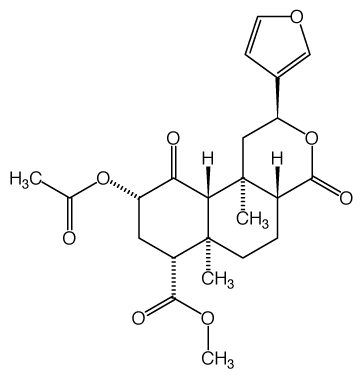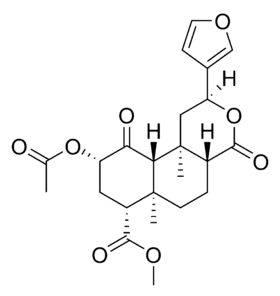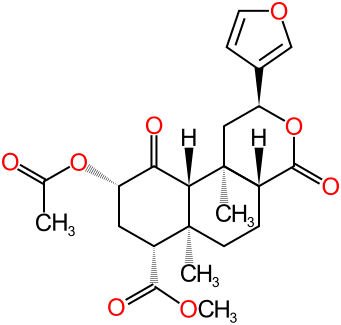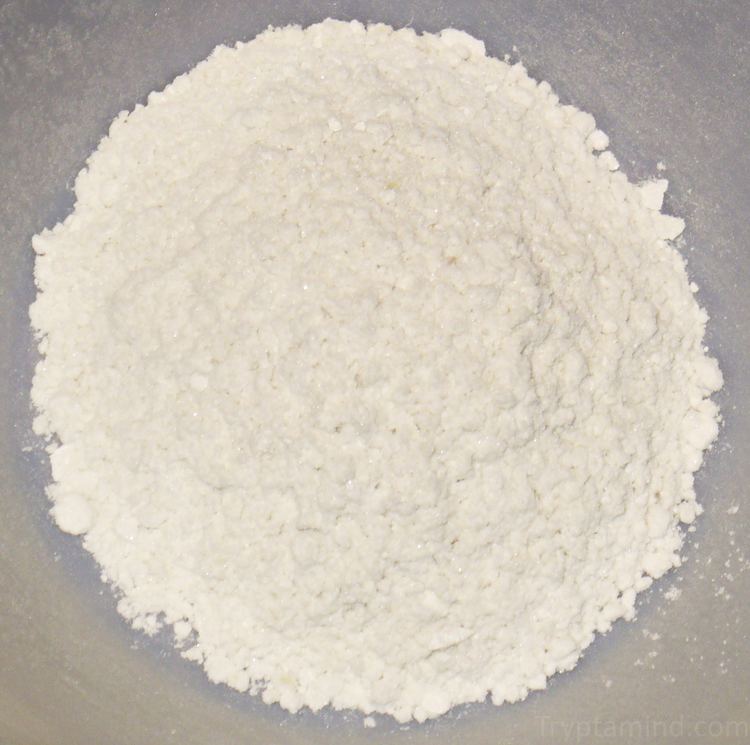ATC code none PubChem CID 128563 Molar mass 432.4636 g/mol | CAS Number 83729-01-5 IUPHAR/BPS 1666 | |
 | ||
Routes ofadministration Buccal/Sublingual, Smoked Legal status AU: S9 (Prohibited)CA: Schedule IVUncontrolled (though Salvia divinorum is controlled in some parts of the world, such as in certain states in the US) | ||
Salvinorin A is the main active psychotropic molecule in Salvia divinorum, a Mexican plant which has a long history of use as an entheogen by indigenous Mazatec shamans. Salvinorin A is considered a dissociative.
Contents
- History
- Pharmacology
- Potency and selectivity
- Effect on intestinal motility
- Solubility
- Detection in urine
- Associated compounds
- Biosynthesis
- Chemical synthesis
- Other salvinorins
- Semi synthetic analogues
- Pharmaceutical action
- Legal status
- United States
- Florida
- Australia
- Sweden
- References

It is structurally distinct from other naturally occurring hallucinogens (such as DMT, psilocybin, and mescaline) because it contains no nitrogen atoms; hence, it is not an alkaloid (and cannot be rendered as a salt) but a terpenoid. It also differs in subjective experience, compared to other hallucinogens, and has been described as dissociative.
Salvinorin A can produce psychoactive experiences in humans with a typical duration of action being several minutes to an hour or so, depending on the method of ingestion.

Salvinorin A is found with several other structurally related salvinorins. Salvinorin is a trans-neoclerodane diterpenoid. It acts as a kappa opioid receptor agonist and is the first known compound acting on this receptor that is not an alkaloid.

History

Salvinorin A was first described and named in 1982 by Alfredo Ortega and colleagues in Mexico. They used a combination of spectroscopy and x-ray crystallography to determine the chemical structure of the compound, which was shown to have a bicyclic diterpene structure. Around the same time, Leander Julián Valdés III independently isolated the molecule as part of his PhD research, published in 1983. Valdés named the chemical divinorum, and also isolated an analog that he named divinorum B. The naming was subsequently corrected to salvinorin A and B after the work was published in 1984. Valdés later isolated salvinorin C.
Pharmacology
Salvinorin A is a trans-neoclerodane diterpenoid with the chemical formula C23H28O8. Unlike other known opioid-receptor ligands, salvinorin A is not an alkaloid as it does not contain a basic nitrogen atom. Salvinorin A has no action at the 5-HT2A serotonin receptor, the principal molecular target responsible for the actions of 'classical' psychedelics such as LSD and mescaline.
Potency and selectivity
Salvinorin A is active at doses as low as 200 µg. Synthetic chemicals, such as LSD (active at 20–30 µg doses), can be more potent. Research has shown that salvinorin A is a potent κ-opioid receptor (KOR) agonist (Ki = 2.4 nM, EC50 = 1.8 nM). It has a high affinity for the receptor, indicated by the low dissociation constant of 1.0 nanomolar (nM). It has been reported that the effects of salvinorin A in mice are blocked by κ-opioid receptor antagonists. In addition, salvinorin A has recently been found to act as a D2 receptor partial agonist, with an affinity of 5–10 nM, an intrinsic activity of 40–60%, and an EC50 of 48 nM. This suggests that the D2 receptor may also play an important role in its effects.
Salvinorin A is unique in that it is the only naturally occurring substance known to induce a visionary state via this mode of action; there are synthetic KOR agonists, (e.g. enadoline, ketazocine, pentazocine and relatives), which show similar hallucinatory and dissociative effects.
Salvinorin A's potency should not be confused with toxicity. Mice chronically given dosages "many times that of what humans are exposed to" did not show signs of organ damage. However, "further studies should be done on blood pressure effects" and "Pulse pressure did appear to increase with salvinorin A exposure twenty and forty minutes after exposure, however, this increase was not statistically significant" (note that the data shows an increase in pulse pressure that was roughly 1.5–2 times the control group's).
Interestingly, salvinorin A shows atypical properties as an agonist of the KOR relative to other KOR agonists. For instance, it is 40-fold less potent in promoting internalization (that is, receptor downregulation) of the human KOR relative to the prototypical KOR agonist U-50488, and it shows minimal antipruritic effects and no analgesic effects in mice, though conflicting reports exist in regards to antinociception. Like most other KOR agonists, salvinorin A does produce effects such as sedation, psychotomimesis, dysphoria/aversion, and anhedonia/depression however. The drug has been found not to produce diuresis in mice, possibly due to its short duration.
Effect on intestinal motility
Salvinorin A is capable of inhibiting excess intestinal motility (e.g. diarrhea), through its potent k-opioid-activating effects. The mechanism of action for salvinorin A on ileal tissue has been described as 'prejunctional', as it was able to modify electrically induced contractions, but not those of exogenous acetylcholine. A pharmacologically important aspect of the contraction-reducing properties of ingested salvinorin A on gut tissue is that it is only pharmacologically active on inflamed and not normal tissue, thus reducing possible side-effects.
Solubility
Salvinorin A is soluble in organic solvents such as ethanol and acetone, but not especially so in water. It is possible Salvinorin A may also be soluble in lipids as are some related terpenoids such as cannabinoids and curcuminoids.
Detection in urine
Humans who smoked 580 μg of the pure drug had urine salvinorin A concentrations of 2.4–10.9 µg/L during the first hour, but the levels fell below the detection limit by 1.5 hours after smoking. Analytical measurements may be performed using gas or liquid chromatography-mass spectrometry.
Associated compounds
Many other terpenoids have been isolated from Salvia divinorum, including other salvinorins and related compounds named divinatorins and salvinicins. None of these compounds have shown significant (sub-micromolar) affinity at the kappa-opioid receptor, and there is no evidence that they contribute to the plant's psychoactivity.
Biosynthesis
The biogenic origin of salvinorin A synthesis has been elucidated using nuclear magnetic resonance and ESI-MS analysis of incorporated precursors labeled with stable isotopes of carbon (Carbon-13 13C) and hydrogen (Deuterium 2H). It "is biosynthesized via the 1-deoxy-d-xylulose-5-phosphate pathway," rather than the classic mevalonate pathway, consistent with the common plastidial localization of diterpenoid metabolism.
Terpenoids are biosynthesized from two 5-carbon precursors, isopentenyl diphosphate (IPP) and dimethylallyl diphosphate (DMAPP). The NMR and MS study by Zjawiony suggested that the biosynthesis of salvinorin A proceeds via the 1-deoxy-d-xylulose-5-phosphate pathway. In the deoxyxylulose phosphate pathway, D-glyceraldehyde 3-phosphate and pyruvate, the intermediates of the glycolysis, are converted into 1-deoxy-D-xylulose 5-phosphate via decarboxylation. Subsequent reduction with NADPH generates 2C-methyl-D-erythritol 2,4-cyclodiphosphate, via the intermediates 4-diphosphocytidyl-2-C-methyl-D-erythritol and 4-diphosphocytidyl-2c-methyl-d-erythritol-2-phosphate, which then lead to IPP and DMAPP.
Subsequent addition of three 5-carbon IPP units to a single 5-carbon DMAPP unit generates the 20-carbon central precursor, geranylgeranyl diphosphate (GGPP). Bicyclization of GGPP by the class II diterpene synthase, ent-clerodienyl diphosphate synthase (SdCPS2), produces a Iabdanyl diphosphate carbocation, which is subsequently rearranged through a sequence of 1,2-hydride and methyl shifts to form the ent-clerodienyl diphosphate intermediate. SdCPS2 catalyzes the first committed reaction in the biosynthesis of salvinorin A by producing its characteristic clerodane scaffold. A series of oxygenation, acylation and methylation reactions is then required to complete the biosynthesis of salvinorin A.
Similar to many plant-derived psychoactive compounds, salvinorin A is excreted via peltate glandular trichomes, which reside external to the epidermis.
Chemical synthesis
A total asymmetric synthesis of salvinorin A, which relies on a transannular Michael reaction cascade to construct the ring system, was achieved in 2007 by Evans and co-workers in 4.5% overall yield over 30 steps. More recently, a synthesis was published by a Japanese group, requiring 24 steps to yield salvinorin A in 0.15% yield.
An approach to the trans-decalin ring system of salvinorin A has been described by Forsyth (et al.) utilizing an intramolecular Diels-Alder reaction/Tsuji allylation strategy.
A recent total synthesis of salvinorin A was reported by Forsyth and co-workers utilizing the intramolecular Diels-Alder / Tsuji allylation approach combined with an asymmetric late-stage addition of the furan moiety.
An attempt at the synthesis of salvinorin A has also been published by a group at RMIT University, adopting a convergent synthesis of a functionalized cyclohexanone with a α,β-unsaturated lactone.
Other salvinorins
Salvinorin A is one of several structurally related salvinorins found in the Salvia divinorum plant. Salvinorin A can be synthesized from the inactive salvinorin B by acetylation. The de-acetylated analog salvinorin B is devoid of human activity. It was speculated that salvinorin C might be even more potent than salvinorin A, but human tests and receptor binding assays could not confirm this. Salvinorin A seems to be the only active naturally occurring salvinorin.
The newly discovered salvinorin J is most closely related to salvinorin E in structure, with a C-17 secondary alcohol instead of a ketone group.
Semi-synthetic analogues
Research on salvinorin derivatives has produced a number of semi-synthetic compounds, several of which can be conveniently made from salvinorin B. Most derivatives are selective kappa opioid agonists as with salvinorin A, although some are even more potent, with the most potent compound 2-ethoxymethyl salvinorin B being 10x stronger than salvinorin A. A few derivatives such as herkinorin have reduced kappa opioid action and instead act as mu opioid agonists.
Pharmaceutical action
Salvinorin A has only been administered to humans in a few studies. One such study found that its effects peak at about 2 minutes, that its subjective effects overlap with those of serotonergic psychedelics, and that it temporarily impairs recall and recognition memory.
Results from a small study by an assistant professor at the University of Iowa indicate that it may have potential as an analgesic and as a therapeutic tool for treating drug addictions. κ-opioid agonists have very marked effects on all types of addiction including alcohol, cocaine, and opiate abuse.
In experimental models of colitis in mice, Salvinorin A has shown to have antiinflammatory and antinociceptive effects mediated by kappa-opioid receptors (KOR) and CB1 receptors.
Legal status
Salvinorin A is sometimes regulated together with its host, Salvia divinorum, due to its psychoactive and analgesic effects.
United States
Salvinorin A is not scheduled at the federal level in the United States. Its molecular structure is unlike any Schedule I or II drug, so possession or sales is unlikely to be prosecuted under the Federal Analogue Act.
Florida
"Salvinorin A" is a Schedule I controlled substance in the state of Florida making it illegal to buy, sell, or possess in Florida. There is an exception however for "any drug product approved by the United States Food and Drug Administration which contains Salvinorin A or its isomers, esters, ethers, salts, and salts of isomers, esters, and ethers, if the existence of such isomers, esters, ethers, and salts is possible within the specific chemical designation."
Australia
Salvinorin A is considered a Schedule 9 prohibited substance in Australia under the Poisons Standard (October 2015). A Schedule 9 substance is a substance which may be abused or misused, the manufacture, possession, sale or use of which should be prohibited by law except when required for medical or scientific research, or for analytical, teaching or training purposes with approval of Commonwealth and/or State or Territory Health Authorities.
Sweden
Sveriges riksdags health ministry Statens folkhälsoinstitut classified salvinorin A (and Salvia divinorum) as "health hazard" under the act Lagen om förbud mot vissa hälsofarliga varor (translated Act on the Prohibition of Certain Goods Dangerous to Health) as of Apr 1, 2006, in their regulation SFS 2006:167 listed as "salvinorin A", making it illegal to sell or possess.
